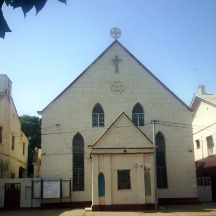
I reviewed three of those chapters, Gambia, where many of our Facebook readers and magazine subscribers live, and South Africa and Kenya, where many of our Facebook readers live. While reviewing the books, I learned that one of the Gambian author/researchers is a former colleague.
Republic of The Gambia
The coverage was very thorough and included many buildings and structures, including the Wassu Stone Circles and Arch 22, that I have visited since I started going to The Gambia in 2002.
However, it’s the Aku houses that got most of my attention. They are located in downtown Banjul, the capital city. The Aku are descendants of the formally enslaved who first repatriated to Sierra Leone and then came to Gambia in the 1820s when the British desired a more skilled, Christian African workforce. Their houses remind me of traditional houses more often seen in the southern parts of the United States.
His capturing aspects of how architecture is affected by politics, belief systems, ectara moved me. He explained: “Apartheid was by definition anti-urban in that it sought to control and keep people apart at all scales of the city . . . Urbanity, on the other hand . . .
It was also good to see that my former colleague Bakary Sanyang of the Gambia National Library had completed some research for this project. He told Port Of Harlem he had done some research on The Wesley Methodist Cathedral, built in 1834.
I have seen this church and others of various Christian denominations in Banjul that often give me eerie feelings of White settlers competing for Black souls simply to increase their denomination’s ranks. Despite their forays, The Gambia remains a religiously tolerant, 90 percent Muslim country.
Republic of South Africa
I found this section most interesting because I barely remember anyone who have visited South Africa talking to me about the architecture, except maybe the memorials. However, the South Africa section provides many examples how the books go beyond brick and mortar to capture the ingredients of architecture and the many aspect of life that influence the art.
.
In “African Cosmology and Architecture,” Franco Frescura pens “Most professional architects practising in Africa today were trained in schools of architecture which taught, almost exclusively, a European syllabus. This stands in sharp contrast to the values inherent in traditional African construction, whose buildings have inherited a tradition rich in ancestral belief, tribal values, environmental adaptation, and social symbolism.”
Another section on the Cape Town Central Business District sums up what I took from this section. “While architecture is an apolitical practice, it is inevitable that – as the ultimately conspicuous and enduring social art – commissions and buildings are politicised. The Bantustan policy of the apartheid ideology gave rise to expansive building programmes, particularly in furnishing ‘capitals’ for the ‘independent’ black states. Some are of an enduring architectural legacy, such as the Legislature Building of Mmbatho (now Mafikeng, capital of North West Province) by Brits and Scholes.”
When writing this review, I thought I would return to a piece on Mphethi Morojele Mphethi Morojele. He is founder and principal of MMA Design Studio in Johannesburg and an award-winning architect and urbanist.
His capturing aspects of how architecture is affected by politics, belief systems, ectara moved me to read and write this now. He explained: “Apartheid was by definition anti-urban in that it sought to control and keep people apart at all scales of the city – from individual buildings to neighbourhoods, and even to regional areas. . . . Urbanity, on the other hand, thrives on diversity, chance encounters, and multiple identities and alliances of all the different actors in the city space.”
Republic of Kenya (Jamhuri ya Kenya)
Of the three, Kenyan architecture seemed most fascinating. Most the contributors to this section are Black and included a section on David Mutiso, the first indigenous Kenyan architect to hold the prestigious position of chief architect at the Ministry of Public Works. He took on the role a few years after Kenya attained independence, and is now a renowned architect.
Mutiso is the founder of one of the country’s leading architectural practices, Mutiso Menezes International, and has laid claim to the design of Kenya’s most iconic building, the Kenyatta International Conference Centre (KICC), which was designed and built during his time as chief architect.
Too often, people force themselves to see Africa having only African and European influences. The Gambia and South African sections refuted that notion somewhat. However, the section on Mombasa strongly disqualified this thought. “Mombasa has therefore been a mixture of cultures, hosting Arab, Persian, Indian, Chinese, Portuguese, and British settlers. This can be seen in the city, though the Islamic influence prevails,” says one passage.
This passage, more than any other, reminded me of an article in our archives, “Zambia or Chambia? - The Chinese in Africa.” I recall the last paragraph: "Dr. Monde Muyangwa, Wilson Center Africa Program Director, also swayed the session’s attention after Yoon Jung Park discussed participation of Chinese who have lived in Africa for multi-generations. To the chagrin of some, Monde added, 'Africans come in all colors.'”






